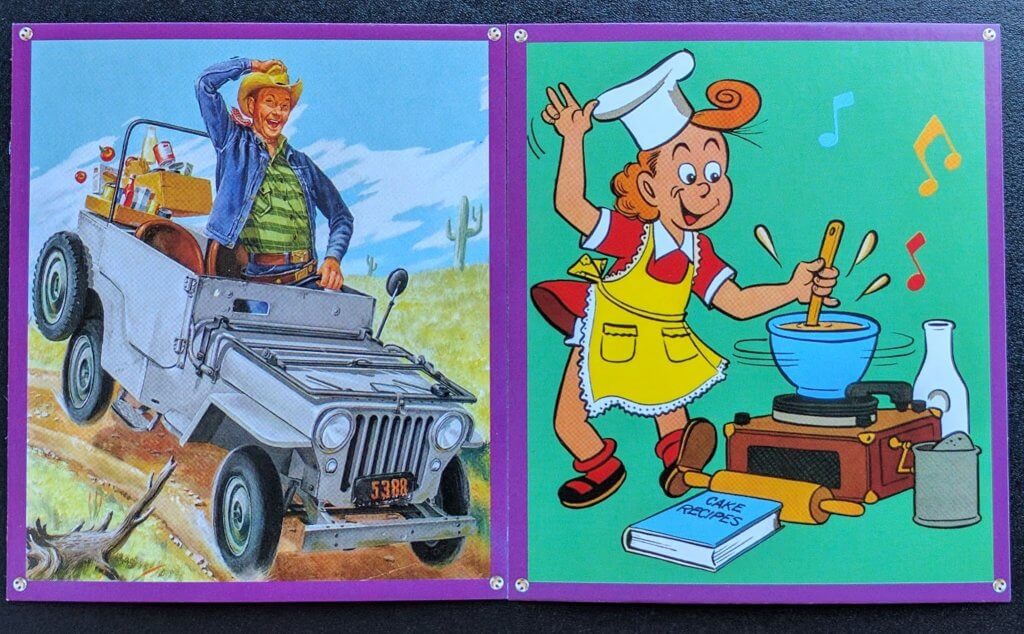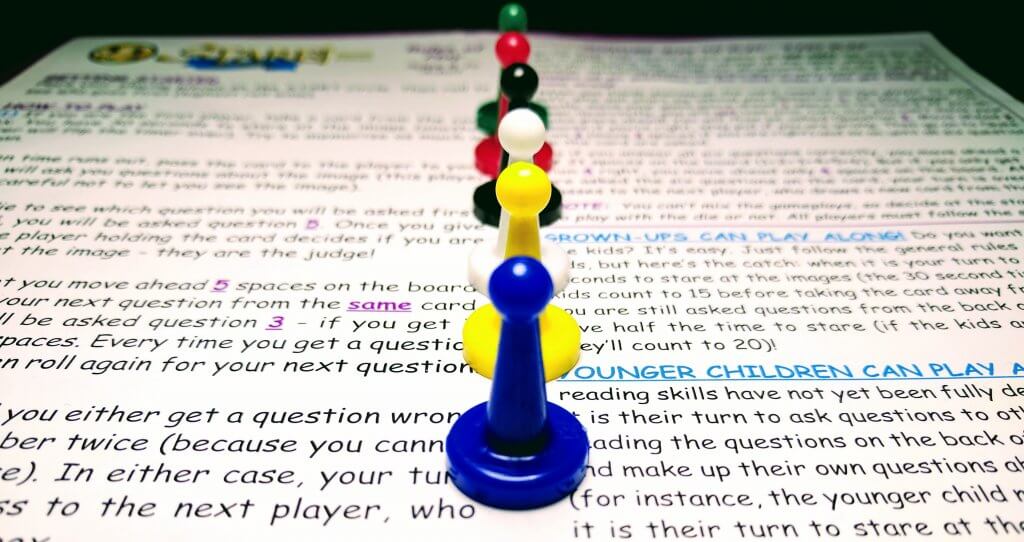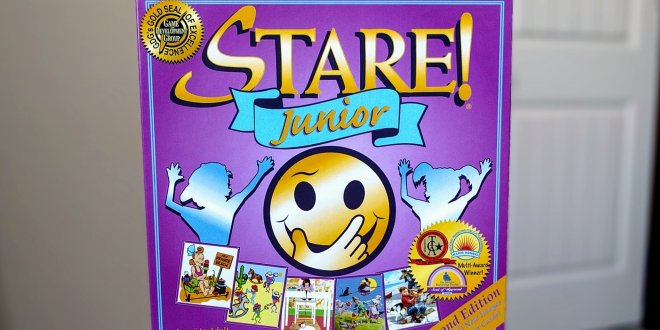QUICK STATS
6 years & up
2 to 6 players
160 cards
20 minutes
Games, Board Games
Memory
Pattern Recognition
Concentration
Time Pressure
Instructions PDF
How many details can you recall in just 30 seconds of looking at a scene? Can your son or daughter remember more than you? If you have a tired brain like me, the answers are “a couple” and “way more than I can,” respectively. Stare! Junior is a fun way to compete with the little ones as you both try to recall the smallest details in an intricate picture. Want to see numerical summary ratings? Skip to the conclusion for our detailed criteria breakdown and final review score.
What’s included & how to play Stare Junior
In the box you’ll find:
- Game board
- 160 image cards each with 6 questions on the back
- 6 pawns to move around the board
- Hourglass timer, 6-sided die, and instructions
Stare Junior relies on the frailty of your short-term working. I can stare at these silly cards forever and notice the smallest details, but take away the image and I forget everything. There’s a small degree of luck involved, though, so after a full-timer has been exhausted (about 30 seconds), just one detail is needed to advance your player. The die randomly assigns one of six questions on the back of your card, which an opponent will quiz you on. If you get the answer right (by skill or by luck), you can move forward.
The images you’ll be observing range from “art” to “pop art” to “just plain ridiculous.” All are older images that have presumably been licensed cheaply or are already in the public domain. Below are two samples:

The imagines you’ll be observing range from “art” to “pop art” to “just plain ridiculous.”
The silly images lend themselves to the use of one common memory trick: using words to describe the picture and helping to encode those details in your memory. You might tell yourself a little story that includes all the relevant parts you think could be tested.
But watch out! The questions can be surprising. An example question for the right card above is “How many musical notes do you see: 2, 3 or 4?” Honestly, those notes just blended into the background for me, so I would have bombed that question. At least you have a 33% chance with the multiple choice versions. Many questions take the form of true/false and yes/no, so you’ll have an even easier time with those.
Is Stare Junior fun and educational?
Stare Junior is indeed fun, but I find it frustrating because I’m so bad at it. I can usually hold my own at strategy games, especially checkers, but this game is vexing for my addled brain. The kids really enjoy it; it’s definitely as fun as any memory game we’ve ever played.
In addition to the fun aspects, Stare Junior teaches four important Rich Skills. Let’s run them down one by one:
- Memory. I’m hesitant to make any claims about actual memory improvement because of the many “memory courses” that try to extract high fees for their “scientific” approach. Even in absence of such claims of improvement, you can’t deny the workout aspects as you try to train your memory enough to win against your little opponents.
- Pattern Recognition. For this game, a better name than pattern recognition might be observation, or visual acuity. The ability to look at an image, discern details, and then hopefully tell yourself a memorable narrative about the scene (aiding recall) will be a skill you’ll want to acquire quickly. This game will help develop this train if you don’t already have it.
- Concentration. I assume everyone can stare for 30 seconds, but to deeply concentrate for that long might not be quite as easy, at first. This is not a game you’ll want to play with a lot of distractions, so get a group of players that will let you observe in silence. I find it amazing how auditory signals block my visual processing.
- Time Pressure. In addition to the focus, you’ll need to make those observations and encode your memories quickly. This is not a game that lends itself to casual play. Those 30 seconds go by fast!
Complete Insanity, CandyChess, and Time2Play
Stare Junior wins big in Complete Insanity because all of the 160 cards are different and losing one won’t matter at all. You’d have to lose a large portion of the cards before you could run out by playing a typical game. The pawns and board are all very simple (aka, generic), so losing them won’t be a big deal either. Overall, it receives a 4.5 out of 5 on this crucial score.
At 3.5 out of 5 on our CandyChess Strategy Score, Stare Junior does reward skill, but it also gives a lot of grace to younger players who can take some guesses and still move their pieces across the board.
You’d have to lose a large portion of the cards before you could run out by playing a typical game.
With only 20 minutes on our Time2Play clock for 2 players, Stare Junior can be a quick before-dinner game snack. If you get 3 or 4 players, you can still complete Stare Junior in less than half an hour, depending on dice rolls. With 6 players, expect the time to creep up toward 40 minutes or longer.
What ages of kids will enjoy Stare Junior?
There’s a pretty small “Goldilocks zone” of “just right” fun for Stare Junior, as shown by our DistribuFun histogram at the left. Only a small age group will get maximum enjoyment from this game; starting at the “tween” years, players will begin to lose interest. It is called Stare Junior, after all. We haven’t yet tried the regular version of Stare to know if it’s more appealing to adults.
The manufacturer claims that ages “6 years & up” will enjoy Stare Junior, but that’s a stretch. It’s by no means maddening like some other kids’ classic games (I experience spiked cortisol levels at the mere sight of Chutes & Ladders), but Stare Junior is not as entertaining for adults as it is for kids.
Alternatives to Stare Junior that teach similar skills
Older players may want to try their hand at the regular version of Stare, which has different images than Stare Junior. Games like Bop It! and Simon are tremendously fun and have been favorites of many generations of kids. They primarily train sequence memory, though, which is a different skill than the image recall in Stare. These electronic interactive memory games enable auditory and tactile clues as well, so they are obviously more multi-sensory than a simple card game could ever be. Choose Stare Junior for a quiet afternoon in a classroom, and Bop It! for a weekend slumber party.
Value, durability, and longevity: Is Stare Junior a good buy?
At around $25, Stare Junior feels overpriced. The quality of the cards are good, but the images are obviously unoriginal and seem somewhat archaic. If you’re a great grandparent, they might be nostalgic, but for me as a millenial parent, I’d rather see something published in the latter half of the 20th century. A licensing opportunity with Disney or another iconic character brand feels like a good opportunity. The quality of everything else is very average. Is there a special factory in China that makes bulk “Sorry!”-style game pawns? Imagine, a factory that only produces those all day long, in an array of colors. These came from that sad, generic pawn factory.

The rules sheet has generous amounts of Comic Sans applied, so the graphic designer came from an era only slightly later than the antiquated cards. This game should be ten bucks.
For durability and longevity, cardboard cards will obviously get easily destroyed, but there are so many of them (as we discussed in Complete Insanity) that it doesn’t concern me. All my complaints about ancient pictures work in favor of a higher longevity score here–this game won’t seem any older 20 years from now than it does today. I’m also guessing that the pawn factory will still be cranking ’em out in 2037, since it’s probably entirely run by robots even now.
 Learn Richly Learning toys, educational games and STEM resources
Learn Richly Learning toys, educational games and STEM resources 
